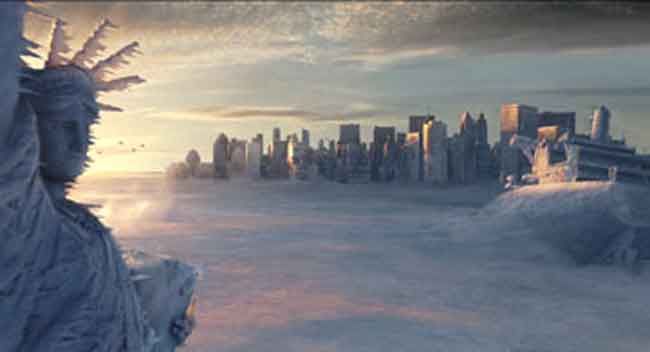
SAN FRANCISCO – Sprinkling some science into Hollywood blockbusters can go a long way toward inspiring the next generation of physicists, astronomers and biologists, such scientists agree.
That was one key message from a panel of scientists, filmmakers and media experts at the fall meeting of the American Geophysical Union this month.
The movie science doesn't even have to be entirely accurate, some of the panelists added when asked to consider the role and impact of science in cinema. As long as it plants a seed of curiosity in viewers, it may spur them to investigate scientific issues on their own — and perhaps consider a career in science down the road.
If the movie is good, that is.
"It's not an educational medium, it's an emotional medium," said Seth Shostak, an astronomer with the SETI Institute (Search for Extraterrestrial Intelligence) in Mountain View, Calif. "Kids get turned on by the emotion."
Shostak has advised Hollywood on a number of feature films, including "Contact."
Hollywood inspiration
Sign up for the Live Science daily newsletter now
Get the world’s most fascinating discoveries delivered straight to your inbox.
Movies can have a tremendous influence on young people with open, malleable minds, the panelists said.
Bruce Rubin, screenwriter of the comet-strike disaster movie "Deep Impact," recalled seeing a 1951 film with a similar theme, "When Worlds Collide," as a child. When he and his friend Billy got out of the theater, Rubin said, they stood on a street corner for four hours talking about the movie, which showed humanity's race to build an escape rocket ship before a rogue star and planet destroyed Earth. [10 Ways to Destroy Earth]
"That movie completely turned my head around," Rubin said.
That movies can make such a powerful impression should come as no surprise, said fellow panelist Arvind Singhal, a professor of communication at the University of Texas, El Paso. Singhal cited several studies showing that people, especially children, often model their behavior on what they see on the big (or small) screen.
"The 'reel' can create the 'real,'" Singhal said.
Panel moderator Sidney Perkowitz, a physics professor at Emory University in Atlanta and author of the book "Hollywood Science" (Columbia University Press, 2007), backed up that sentiment, referencing the 2004 climate-change disaster film "The Day After Tomorrow."
"It actually changed people's minds about global warming," Perkowitz said.
The impact of feature films dwarfs that of most other genres, he added. "The Day After Tomorrow" grossed $544 million in international ticket sales. Al Gore's Oscar-winning global-warming documentary, "An Inconvenient Truth," raked in just $49 million.
Attention to detail may not be necessary
Science shows up in many Hollywood films. According to Perkowitz, 22 of the 60 top-grossing movies of all time are science-fiction or superhero flicks, including history’s No. 1 box office hit, "Avatar."
Some movies work hard to get the science right. But many make errors ranging from the understandable to the egregious, panelists said. As an example, Shostak brought up "Avatar." In the film, humans travel to a fictional extrasolar moon, Pandora, to mine a precious mineral said to be worth $20 million per kilogram (2.2 pounds).
According to Shostak, that's not valuable enough to justify traveling so far. Pandora is said to be in the Alpha Centauri star system, more than 4 light-years from Earth, or about 24 trillion miles (40 trillion kilometers). Spaceship fuel costs would chew through any potential profits, and fast.
"The basic premise of this film is bonkers," he said. Flying to Pandora for the mineral is "equivalent to ordering a book from Amazon and paying $60,000 for shipping."
Though accuracy is preferable, even error-filled films can have a positive impact, Shostak said. As a kid, he saw many sci-fi movies that took lots of liberties with the science.
"It didn't matter," he said. "They got you hooked emotionally."
Getting a kid hooked, he added, may lead that kid to read up on science and scientific issues. And that might be the first step in creating a future scientist.
Sometimes the error itself can inspire discussion and learning, others said.
"Even if a film or media product is not very accurate, that becomes a teaching moment," Singhal said. "So there's room for everything."
Rubin dissented somewhat, saying he thinks scientific accuracy in films is quite important. Kids today aren't reading much, he said, so they glean a large portion of what they know about the world from TV, movies and video games. Since these media deliver the foundation of many children's worldview, it's better if that foundation were based on solid information.
Science can make for good stories
The potential to get science into the movies — and therefore into more people's heads — is vast, panelists said, because science is full of lots of good stories. And good stories make good movies.
"There's so much out there in the world of science that would make great storytelling," Rubin said.
Panelist Jon Amiel, who directed the Charles Darwin biopic "Creation" and the Earth-science disaster flick "The Core," agreed.
Movies would do well, Amiel said, to show "the huge, endlessly exciting mystery that's inherent in all scientific exploration."
Mike Wall is a Senior Writer for SPACE.com, a sister site of Live Science.












